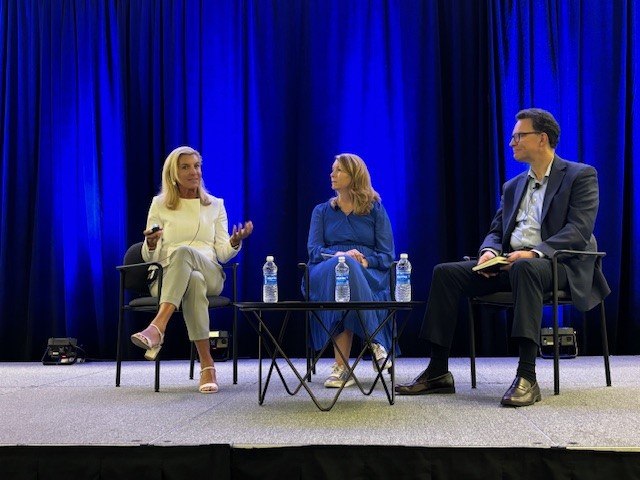No rest for the weary: difficult times continue to pose challenges for retailers and manufacturers.
Earlier this month, the dreaded word “recession” dominated the headlines following a gloomy jobs report and the subsequent collapse in stock markets.
While recent economic data and reports have calmed fears of a recession, consumers continue to feel the effects of ongoing inflation, cutting back on spending and changing their shopping habits to get more out of their money.
But it’s not all doom and gloom for retailers. Retailers and consumer goods manufacturers are using myriad strategies to increase sales and customer loyalty – even during turbulent times, says Jill Blanchard, president of intelligence and insights at Advantage Solutions.
Advantage acts as a strategic advisor and provider to CPG brands and retailers, guiding many of them through turbulent economic conditions and changing consumer preferences.
Blanchard, speaking at the National Association of Chain Drug Stores’ Total Store Expo in Boston on Monday, highlighted some challenges and opportunities in the market and shared insights from the quarterly Advantage Outlook report. Joining her on the panel were Rachel Marler, U.S. chief customer officer at Haleon, and Stephen Carrou, executive sales director, Alcon US OTC Business.
Here are six key takeaways from Blanchard’s presentation:
Value. Value means different things to different consumers. Bottom line: Most consumers think about value first and foremost when shopping. Some shop across categories and brands, while others buy larger packs to get a better price, Blanchard says. For retailers, the increasing focus on private labels is proving prescient in giving consumers the value they’re looking for, she notes. And both retailers and manufacturers are focusing on more promotions and larger packs.
“We hear a lot about inflation, but not all consumers are the same, so manufacturers and retailers need to pursue more than one strategy to meet shoppers’ value needs,” says Blanchard.
Innovation. It’s back! But it’s also unclear what role it will play in the current economy.
More than a third of manufacturers are going full throttle with their innovation pipeline, but retailers are less optimistic – only 13% say they would embrace more innovation from national brands. In contrast, 28% of retailers say they would embrace more innovation from private brands. In addition, retailers want to see more innovation at a lower price than what manufacturers say they are bringing to market.
Loss due to theft. Yes, it’s still a problem – for retailers, manufacturers and, ultimately, consumers. The Advantage Outlook for Q2 2024 found that retailers will continue to rely on video surveillance and in-store security guards to prevent theft. They also plan to discontinue some products, particularly in the more expensive, smaller-packaging categories such as cosmetics and facial, ear and eye care. This is an unfortunate outcome, Blanchard says, because discontinuing these products doesn’t solve the customer service problem.
“Until there are better ways to identify and limit the online sale of stolen items and thus prevent theft, we must address this problem on an item-by-item and store-by-store basis,” Blanchard said.
Test and learn. When it comes to finding successful strategies, test-and-learn is an important tactic that allows retailers and manufacturers to measure the potential of new products or sales approaches before fully implementing them. Retailers conduct more test-and-learn efforts than manufacturers: three-quarters test price promotions and nearly two-thirds test new items, according to the Advantage Outlook.
“Test-and-learn principles are more important today than ever as retailers and manufacturers strive to meet the demands of consumers with new and sometimes conflicting needs,” says Blanchard.
Omnicommerce priorities. First, the good news: Online sales remain strong and both manufacturers and retailers are using omnichannel selling to grow their overall business. But there are also great opportunities to improve the online shopping experience and convert more shoppers into consumers.
Manufacturers and retailers alike say their top omni-commerce priorities are optimizing digital shelf content—which is just as important as correctly pricing and displaying products in the store—and investing in retail media networks.
Differentiation is key. The vast majority of retailers and manufacturers have strategies for success that are… remarkably similar. For manufacturers, it’s expanded distribution, innovation, and promotions; for retailers, it’s loyalty programs, pricing, private labels, and promotions.
“Not everyone can win with the same strategies,” Blanchard says. “I wish that were possible, but that’s probably not going to happen. So if you have similar plans and strategies, you have to differentiate yourself to win.”
How do manufacturers and retailers plan to differentiate themselves? According to Advantage Outlook, new distribution channels and differentiated innovations are the key differentiation strategies for manufacturers, while retailers will focus on differentiated promotions and exemplary loyalty programs.
What will the outcome be? And will there be winners and losers? “Let’s see what happens,” says Blanchard. “We’re keeping our fingers crossed for everyone.”
Ultimately, success will be measured by how well retailers and manufacturers manage to gain and maintain shopper loyalty despite ongoing economic challenges.

